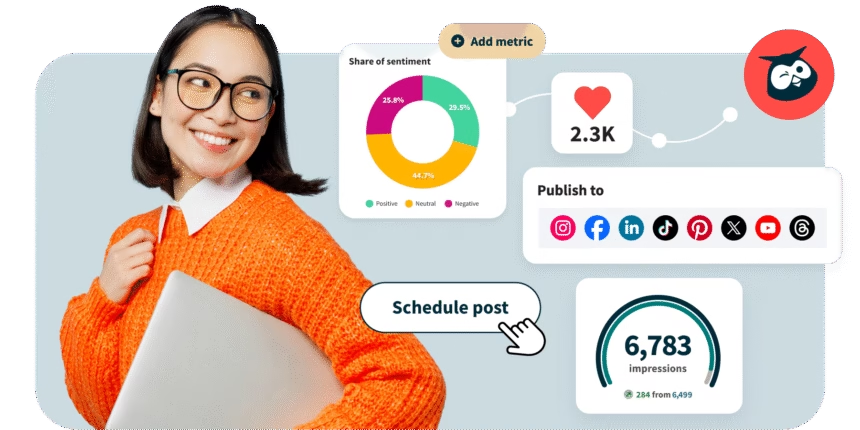Struggling to write captions that actually get clicks, saves, and shares? You are not alone. A few lines decide if your post gets buried or blows up. That is where an AI caption generator helps, turning your ideas into scroll-stopping copy in seconds.
An AI tool that writes viral captions uses models trained on style, tone, and platform rules. You type a goal and a topic, it suggests hooks, value-packed lines, a strong call to action, and smart hashtags. It speeds up your workflow and keeps your voice consistent across Instagram, TikTok, LinkedIn, and more.
In this guide, you will get a simple plan. You will see how these tools work, the best options in 2025, a repeatable workflow, and ready-to-use prompt templates. Expect real examples from Buffer’s AI Assistant, SuperAGI Caption Creator, QuillBot AI Caption Generator, HubSpot AI Social Media Post Generator, Hootsuite OwlyWriter, CaptionCraft Pro, SocialBee, and Later’s Free Caption Generator.
Great captions follow a few rules. Start with a sharp hook, share clear value, add one action you want the reader to take, then finish with relevant hashtags. We will show you how to do this fast, with prompts you can copy, refine, and reuse.
Want more reach without guessing? Stick around for tool picks by use case, a 10-minute caption workflow, and prompts for launches, tutorials, carousels, Reels, and UGC. By the end, you will publish with confidence and see more saves, shares, and clicks.
How AI Caption Generators Make Posts Go Viral
AI tools study patterns from high-performing posts. They predict what grabs attention, then suggest hooks, tone, hashtags, and CTAs that fit your platform. This boosts the metrics that matter most: watch time, comments, and saves. Longer watch time and more interactions tell the algorithm your post is worth pushing to more people.
The building blocks of a viral caption: hook, value, CTA, and length
- Hook: The first line that stops the scroll. It sets the promise.
- Bold claim: “I grew 10k followers in 30 days using this.”
- Curiosity gap: “Most creators skip this one tiny step.”
- Value: The payoff. Share a tip, insight, or result in clear, simple terms.
- CTA: Tell readers what to do next. Keep it direct, one action.
- Length: Short captions suit fast formats like TikTok and Reels. Longer captions work for Instagram carousels and LinkedIn when you teach or tell a story.
Short examples:
- TikTok/Reels: “3 editing tricks for smoother cuts. Save this.”
- TikTok/Reels: “Stop losing views at 3 seconds. Do this.”
Story-style Instagram example:
- “I almost quit posting last year. Then I changed one thing: batch on Sundays. Here is how I plan 7 posts in 45 minutes…”
Sample CTAs:
- “Comment ‘guide’ and I will DM the checklist.”
- “Save this so you can try it later.”
- “What part would you test first?”
Use trending hashtags the smart way
AI tools scan your topic and current trends, then propose tags with high relevance. Keep it clean:
- Mix broad and niche tags.
- Avoid banned or spammy tags.
- Use a small, focused set.
Fitness example: #hypertrophy #legdaytips #beginnerworkout #glutetraining #garagegym. Track which tags drive reach and saves in your analytics. For updated best practices, see this quick guide on smart hashtag usage in 2025: The Ultimate 2025 Guide to Social Media Hashtags.
Match tone to each platform without losing your brand voice
- Instagram: Friendly, helpful, and skimmable. Use short lines and emojis sparingly.
- TikTok: Casual, playful, and direct. Front-load the hook.
- YouTube Shorts: Clear, benefit-first, and search-friendly keywords.
- LinkedIn: Practical, credible, and concise. Lead with a takeaway.
Keep a simple voice guide with “do” and “do not” rules:
- Do: short sentences, plain words, 1 clear action.
- Do not: vague claims, long intros, 10 hashtags.
Before vs after, same idea:
- Before: “New video up.”
- After for TikTok: “You are editing Reels too slow. Try this 1-tap cut.”
- After for LinkedIn: “Cut editing time by 40 percent with these 3 shortcuts.”
Consistency builds trust, which boosts clicks and shares over time.
Common mistakes that kill reach and how to avoid them
- Clickbait that does not deliver: Make a clear promise, then answer it fast.
- Walls of text with no breaks: Use short lines, emojis as markers, and spacing.
- Too many hashtags: Stick to a small, relevant set.
- Posting at the wrong time: Check when your audience is usually active and post near that window.
- Ignoring comments: Reply fast, ask a follow-up question, and pin a helpful answer.
Quick checklist: hook, value, CTA, hashtags, tone, timing.
Best AI Tools in 2025 for Viral Captions and When to Use Each
Choosing the right tool comes down to speed, control, and budget. Here is a quick guide by use case so you can ship more posts with stronger hooks and cleaner CTAs. For a broad comparison of features across popular picks, see this 2025 roundup on AI caption tools: Top 10 AI Social Media Caption Generators for 2025.
Fast ideas and repurposing: Buffer’s AI Assistant
If you need quick caption drafts and easy scheduling, Buffer fits. It turns one idea into multiple platform-ready options and keeps tone consistent inside the planner.
Suggested workflow:
- Paste a blog link or a one-line idea.
- Generate several caption options.
- Tweak tone and add a clear CTA.
- Pick hashtags, schedule, and track results.
- One-line summary: Fast caption variations tied to your calendar.
- Best for: Creators or small teams that value speed.
- Pros: Repurposes from links, tone control, built-in scheduling.
- Limits: Fewer deep analytics than heavyweight suites.
Power features and analytics: SuperAGI, HubSpot, and Hootsuite
These tools suit brands that want control, language support, and reporting.
- SuperAGI Caption Creator: Brand voice matching, many languages, and hashtag tips help scale across regions. Best for global teams and campaign testing.
- Pros: Voice tuning, trend-aware suggestions.
- Limits: Setup takes time for best results.
- HubSpot AI Social Media Post Generator: Ties captions to goals, tracks performance, and supports repurposing. Best for marketing teams that report on ROI.
- Pros: Analytics, workflows, CRM context.
- Limits: Features live inside the HubSpot ecosystem.
- Hootsuite OwlyWriter: Drafts posts from URLs, events, or holidays, then publishes to many platforms. Best for teams managing several accounts.
- Pros: Multi-platform support, fast ideation.
- Limits: Can feel heavy if you only need captions.
Creative styles and team work: QuillBot AI Caption Generator
QuillBot shines when you test voice and need edits from multiple people. Switch tone from funny to professional, compare versions, and keep language tight with built-in writing tools.
- One-line summary: Flexible styles with smooth team editing.
- Best for: Brands that run approvals or A/B test voice.
- Pros: Tone switching, templates, collaboration.
- Limits: Not a full social scheduler, pair with a posting tool.
Budget and free picks: CaptionCraft Pro, Later’s Free Generator, and SocialBee
If you watch costs, these tools help you move fast without bloat.
- CaptionCraft Pro: Budget-friendly and focused on quality captions with tone and CTA controls. Best for beginners refining voice.
- Pros: Clean interface, clear prompt guidance.
- Limits: Fewer platform integrations.
- Later’s Free Caption Generator: Quick ideas connected to a scheduler and hashtag help. Best for simple workflows and creators who already plan in Later.
- Pros: Easy, scheduling tie-in.
- Limits: Free tier has fewer options.
- SocialBee: Customizable prompts and categories support consistent posting at scale. Best for solo creators and small teams.
- Pros: Prompt library, content organization.
- Limits: Advanced analytics may require other tools.
Step-by-Step Workflow to Get Captions That Win
Use this quick workflow to go from idea to published post without losing your voice. Follow the steps in order, keep prompts tight, and let analytics guide edits in the next round.
Checklist with tools:
- Brand voice brief: QuillBot, CaptionCraft Pro
- Prompts and generation: Buffer, SuperAGI, Later
- Edit and polish: QuillBot, SocialBee
- A/B testing and analytics: HubSpot, Hootsuite
- Scheduling and calendar: Buffer, Hootsuite, Later
Mini weekly timeline:
- Monday: Voice brief refresh and prompt setup
- Tuesday: Draft and edit
- Wednesday: A/B test posts 1 and 2
- Thursday: Review analytics, update hooks
- Friday: Schedule next week and block time to reply
Build a brand voice brief in 10 minutes
A simple brief keeps every caption on-brand and saves time across tools.
Copy this template:
- Audience: who they are, level, and goals
- Pain points: top 3 problems
- Tone words: 3 to 5 words, like helpful, direct, witty
- Do rules: short lines, 1 clear CTA, active voice
- Do not rules: clickbait, vague claims, jargon
- Emoji rules: max 2 per caption, use as line markers
- Banned phrases: anything you never want to post
Save it as a system prompt in your AI tool so every draft stays consistent.
Write better prompts the AI understands
Use this formula: role, audience, goal, platform, tone, length, CTA, hashtags.
Paste one key fact or benefit to anchor the copy.
Examples:
- Instagram: “You are a social copywriter. Audience: beginner fitness creators. Goal: saves. Platform: IG carousel. Tone: friendly, practical. Length: 90 to 120 words. CTA: Save for later. Hashtags: 5 niche. Key fact: ‘This plan cuts editing time by 40 percent.’”
- TikTok: “You write short hooks. Audience: skincare shoppers. Goal: comments. Platform: TikTok. Tone: punchy, playful. Length: 1 to 2 lines. CTA: Ask a question. Hashtags: 4. Key benefit: ‘SPF reduces dark spots over time.’”
For extra prompt tips, check this guide on AI prompts for social media in 2025.
Test, measure, and iterate with analytics
Run a simple A/B test: two hooks, same post body. Post at the same time window. Track saves, comments, and reach for 48 to 72 hours. Use HubSpot or Hootsuite to link captions to performance.
Read comments to lift real phrases your audience uses. Turn repeated words into future hooks and hashtags.
Schedule posts and keep a content calendar
Pick 2 to 3 posting slots based on past performance. Keep a weekly calendar with themes, hooks, and CTAs. Buffer, Hootsuite, and Later make planning and scheduling simple.
Leave 15 to 20 minutes after each post to reply. Fast replies boost comments and reach.
Copy-and-Paste Prompt Templates for Viral Captions
Use these ready-to-go templates to speed up your captions. Start with a sharp hook, add clear value, then give one simple action. Replace placeholders like [audience], [benefit], and [brand] with your real details. For more hook ideas you can adapt, see this roundup of Instagram hooks: Best Instagram Hooks for Content Creators for 2025.
Hooks that stop the scroll
Short, punchy hooks spark curiosity or promise a clear win. Use one per post and match the tone to your audience.
- Question hook: “Still doing [old way]? Try this instead.”
- Number hook: “7 fixes for [pain point] starting today.”
- Myth vs fact: “Myth: [common belief]. Fact: [truth in 6 words].”
- Surprising result: “We cut [problem metric] by 43 percent in 2 weeks.”
- Secret hint: “The part no one tells you about [topic].”
- Mistake callout: “If you do [habit], you are losing [result].”
- Step one tease: “Do this first for faster [outcome].”
- Time hook: “Give me 60 seconds, get [benefit].”
Copy-paste prompt to generate hook options: You are a social copywriter. Create 20 short hooks for [platform], audience [audience], about [topic]. Focus on curiosity, urgency, or a bold outcome. Keep each under 12 words. No clickbait. Return in a simple list with no extra text.
CTAs that drive comments and shares
Make the ask simple. Use one action per post and set clear expectations.
- Comment your top pain point.
- Drop an emoji if you want the checklist.
- Save this for your next [task].
- Tag a friend who needs this tip.
- Vote with an emoji: 👍 for A, 🔁 for B.
- Reply “guide” and I will DM the steps.
- Share this to your story if you agree.
- Comment “link” for the resource.
- DM me “audit” for feedback.
- Tell me which step you will try first.
Copy-paste prompt to generate CTA options: List 25 short CTAs for [platform] that drive comments, saves, DMs, or shares. Audience is [audience]. Keep each under 10 words, action-first, and specific. Do not repeat verbs. Output as a numbered list without extra explanations.
Hashtags and emoji that do not look spammy
Use a tight set of tags and emojis as signposts, not decoration. Keep captions clean and readable.
- Simple hashtag recipe:
- 2 broad tags for reach.
- 3 niche tags for intent.
- 1 branded tag for identity.
- Emoji rules:
- Use to guide eyes, not replace words.
- Place near the hook or the CTA.
- Stick to 1 to 2 total.
Clean example you can copy: “3 fixes for shaky Reels. Try #2 today. 👇 Save for later.
#socialmedia #contenttips #reelstutorial #videotipsforbeginners #growthstrategy #[YourBrandTag]”
Copy-paste prompt to generate hashtag sets: Generate 6 hashtag sets for [platform] about [topic]. Each set must include 2 broad tags, 3 niche tags, and 1 branded tag #[YourBrandTag]. Ensure tags are relevant, non-spammy, and common in the US. Output 6 clean lines I can paste.
Short, medium, and long caption formats
Pick the format that fits the post type and attention span. Keep one clear CTA and add hashtags where the reader expects them.
- Short one-liner (Reels or TikTok)
- Template: “Stop [pain point]. Do this for faster [benefit]. Save this. #tag1 #tag2 #tag3”
- CTA goes at the end, then 3 to 5 hashtags.
- Copy-paste prompt:
Write 10 short one-liner captions for [platform] about [topic]. Audience is [audience]. Keep under 14 words, benefit-first, with a clear CTA and 3 relevant hashtags. No fluff. Return as separate lines ready to paste.
- Medium list style (Instagram)
- Template:
- Hook: “You are losing views by doing this.”
- Value: “1) Cut the first 2 seconds. 2) Lead with the result. 3) Add captions.”
- CTA: “Comment which step you will try.”
- Hashtags after a line break, 4 to 6 total.
- Copy-paste prompt:
Create 5 Instagram captions in list format for [topic]. Start with a bold hook, include 3 to 5 actionable steps, then a single CTA aimed at comments or saves. Add 4 to 6 relevant hashtags on the last line. Audience is [audience].
- Template:
- Story-style caption (Carousels or LinkedIn)
- Template:
- Hook: “Last month I almost quit posting.”
- Story: “I was stuck at 2 percent saves. Then I tested one change: front-load the result. Saves jumped to 7.2 percent in 10 days.”
- Lesson: “Lead with the win, then teach the step.”
- CTA: “Reply ‘plan’ for the checklist.”
- Hashtags at the end, 3 to 5 max.
- Copy-paste prompt:
Write 3 story-style captions for [platform] about [topic]. Use a personal moment, the change you made, the result with a number, then the lesson. Finish with one direct CTA and 3 to 5 hashtags. Keep each 120 to 180 words.
- Template:
Replace every placeholder with real names, numbers, and brand details so your captions feel human and trustworthy.
Conclusion
AI caption tools turn ideas into clear, high-impact lines that drive saves, comments, and clicks. They help you pick a strong hook, match tone to each platform, and add focused hashtags without guesswork. For 2025, quick drafting and planning fit Buffer and Later, deeper control and analytics suit SuperAGI, HubSpot, and Hootsuite, and flexible voice testing works well in QuillBot, with SocialBee and CaptionCraft Pro covering budget and consistency.
Follow the simple workflow you saw: lock your voice brief, write tight prompts, generate options, edit once, A/B test two hooks, then review analytics and schedule. Keep one CTA, short lines, and a clean tag set.
Pick one tool today and test two hooks this week. Post at your best time window, then watch saves and comments for 48 to 72 hours.
Bookmark the prompt templates above, they will save you hours. Try a hook test, then share your results in the comments so we can learn together.















